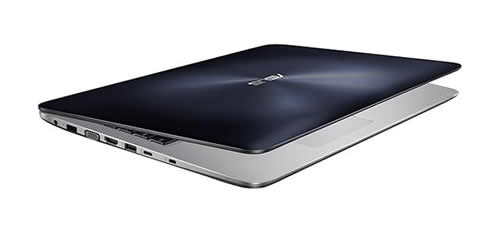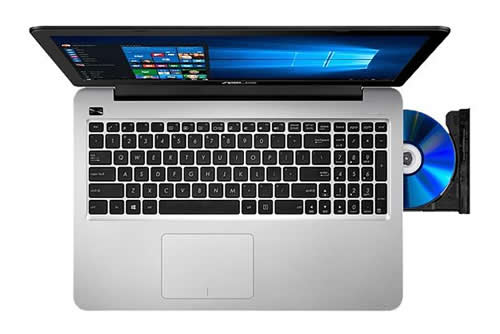ASUS has recently rolled out another model belonging to their F series, specifically the ASUS F556UA-EB71, a direct descendant of the popular F555UA-EH71 model I’ve reviewed some time go.
Review
The ASUS F556UA-EB71 is a mid range laptop that’s designed to work as a multimedia center for the house or as a desktop replacement unit, since its components are geared primarily towards practicality.

Portability, build quality and aesthetics come second for this affordable powerhouse, but that doesn’t mean you can’t carry it to work or to a cafe, just that there are other, more adequate laptops for that job.
Performance
The ASUS F556UA-EB71 notebook has a Intel Core i7-6500U quad core processor inside, which comes with a cache size of 4 megabytes, a frequency range between 2.5 GHz and 3.1 GHz and a thermal design power of 15 Watts. As far as mobile processing units go, this is one of the most well rounded one out there, since it offers great processing power without consuming large amounts of energy while doing so. Benchmark tests rate this CPU at around 4300 points, meaning you’ll be able to multitask with ease and run most programs without hurdles.
Read user reviews at Amazon.com »
System memory size is rated at 8 gigabytes of DDR3L SDRAM, further cementing its multitasking abilities. You shouldn’t need additional memory for the laptop to perform well, but it’s worth mentioning you can double that amount by adding or replacing the existing memory sticks. Should you decide to do this, check the availability of free memory slots and the configuration of the already installed 8 gigs (whether it’s 2x4GB or 1x8GB).
The one terabyte of storage space is abundant, but it does come as a mechanical hard disk drive, which will make the overall experience a bit slower. This is the most outdated piece of equipment on the ASUS F556UA-EB71, and although you won’t be noticing much lag, getting a solid state drive down the road sometime in the future will surely refresh the system and bring it up to upcoming software standards – but you should really think about that kind of upgrade in about 2 years.
Unfortunately, the ASUS doesn’t have a discrete video card, which means any games that will be played will have to rely on the integrated Intel HD Graphics 5500 card – a grim outlook. You’ll be able to play most MMOs with success, as well as some older games, but any new titles will either be unplayable or will run at abysmal frame rates and low graphics settings.
Display
The ASUS F556UA-EB71 has a 15.6 inch matte LCD screen and unlike its predecessor, the EH71, finally features a Full HD display with a resolution of 1920 x 1080 pixels. Text will be rather small-ish on this display, but the clarity and crispness of the images should compensate well.
Interface
Here we see levels of connecting through various mediums similar to another related model, the AS54 laptop. Thankfully, they are aplenty:
- 1 x USB-C port
- 2 x USB 3.0 ports
- 1 x HDMI-out
- 1 x VGA/Mini D-sub
- 1 x Audio combo jack
- 1 x RJ45 LAN jack
- 1 x SD card reader
Connectivity
Connecting to the Internet is handled by a dual-band 802.11ac wireless card and via Ethernet (10/100/1000 Base T connection). Also, the laptop comes with integrated Bluetooth 4.0 technology. Dual band technology basically allows your device to connect to either 2.4 GHz or 5 GHz channels, effectively increasing your chances to find uncluttered wireless real estate.
Other features
- DVD-Writer – Not useful for ultra portable devices, but sensible in this case, should this laptop be used as a work station or a home multimedia center.
- ASUS IceCool Technology
- ASUS SonicMaster Technology
- VGA webcam
Battery life and portability
The battery pack is identical to the one used in the AS54 model – 2-cell, 37 Whr. A full charge should last some 7 to 8 hours tops. I think that’s more than fair for a mid-range laptop and shouldn’t pose any problems for those who use it around the house, the office or even at college.

Weighing 5 pounds, the ASUS F556UA-EB71 isn’t one of the lightest or smallest devices out there, so if you plan on travelling a lot with it, you should probably think about choosing another, more appropriate model. However, the people at ASUS managed to reduce the width of the laptop to 1 inch, down from 1.08 inches – barely noticeable progress, but a step in the right direction nonetheless.
Conclusion
All in all, ASUS managed to improve an already successful and well balanced laptop. The refreshed technology, alongside with new hardware additions make this laptop a worthy successor of the popular models that preceded it. It’ll work great as a budget friendly and versatile home/work/home office/college laptop, but won’t perform great on the road, especially if you travel much.





